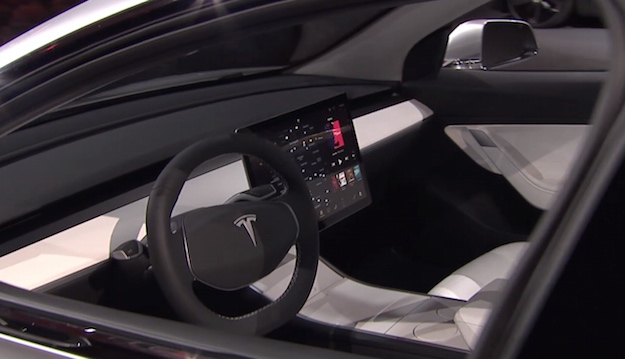This past Friday, Tesla CEO Elon Musk dashed the hopes and dreams of prospective Model 3 owners with just a few simple tweets. Tempering expectations, Musk emphasized that Tesla's upcoming Model 3 will not be more advanced -- in any capacity -- than the company's flagship Model S.
"Model 3 is just a smaller, more affordable version of Model S [with] less range & power & fewer features," Musk said. "Model S has more advanced technology." Musk later added that the Model 3 will not feature the elegant "auto extend handles" Tesla introduced on the Model S.
While Muks's comments here might seem obvious, the reality is that some of the hype and speculation surrounding the Model 3 had reached bizarre levels in recent months. Case in point: because the Model 3 prototype Tesla unveiled last year lacked an instrument panel with traditional gauges for items like speed, range and other pertinent information, many Tesla enthusiasts began wondering if Tesla had some special plan for the dashboard, with many believing that a heads up display (HUD) on the windshield was an inevitability.
As a quick reminder, here's a photo of the Model 3 interior taken from the company's special event last year. As is evident below, the only location a driver can access information is the 15-inch touchscreen in the center console.

In another shot, we can see that Model 3 drivers will have to divert their eyes to the upper left hand corner of the display in order to ascertain their current speed.

Alas, Tesla doesn't have any secret plans to implement some advanced HUD on the Model 3. In a tweet addressing the matter, Musk said that as cars become more autonomous, the need for a suite of information at the ready becomes less of an issue.
https://twitter.com/elonmusk/status/845285846936825856
Still, we're still a long ways off before fully self driving cars become commonplace. In turn, it remains to be seen if the Model 3 design in its current incarnation is perhaps too far ahead of its time. Besides, autonomous driving features for the Model 3 will cost extra, meaning that not every Model 3 on the road will be able to take advantage of the vehicle's self-driving capabilities.
One question about the Model 3 that remains unanswered is whether or not can expect any changes to the car's steering wheel design. This past April, Musk boasted that the final design will be akin to a spaceship.
https://twitter.com/elonmusk/status/716729420078133248
To answer that, we'll probably have to wait until next July when Tesla is planning the next phase of its Model 3 reveal.
Anyone who's played a futuristic shooter since the dawn of video games knows that when you see something called a "railgun" you're in for a real treat. Well, the US Navy built a railgun of its very own, and it just showed off its remarkably powerful creation in a new video of its test firing.
https://www.youtube.com/watch?time_continue=106&v=Pi-BDIu_umo
Railguns like the one the Navy has built trade chemical propellants like gunpowder for the sheer power of electricity, generating extremely strong magnetic fields to push a projectile down a set of rails and out the end of the barrel. It might not sound particularly efficient, but the speeds that railgun projectiles can achieve put traditional cannons to shame. The Navy's massive weapon, for example, launches its rounds at a whopping 4,500 mph.
Additionally, the projectiles launched by the railgun do their damage not by exploding, but simply by striking their target while moving at such a high speed, quite literally tearing apart anything they come into contact with.
For most of their history, railguns have been more fiction than science, and their practicality and reliability has repeatedly been questioned over time. The size of the device itself is typically massive, owing to the large and complex electronic components required to supply the necessary power. However, there are also some pretty fantastic benefits of the non-explosive rounds, such as much less chance of unexploded ordnance causing problems either on the ship or vehicle firing the weapon, or on the battlefield after a skirmish has ended.
Russia’s opposition, often written off by critics as a small and irrelevant coterie of privileged urbanites, put on an impressive nationwide show of strength Sunday with scores of protest rallies spanning the vast country. Hundreds were arrested, including Alexei Navalny, the anti-corruption campaigner who is President Vladimir Putin’s most prominent critic.
Anyone who's played a futuristic shooter since the dawn of video games knows that when you see something called a "railgun" you're in for a real treat. Well, the US Navy built a railgun of its very own, and it just showed off its remarkably powerful creation in a new video of its test firing.
https://www.youtube.com/watch?time_continue=106&v=Pi-BDIu_umo
Railguns like the one the Navy has built trade chemical propellants like gunpowder for the sheer power of electricity, generating extremely strong magnetic fields to push a projectile down a set of rails and out the end of the barrel. It might not sound particularly efficient, but the speeds that railgun projectiles can achieve put traditional cannons to shame. The Navy's massive weapon, for example, launches its rounds at a whopping 4,500 mph.
Additionally, the projectiles launched by the railgun do their damage not by exploding, but simply by striking their target while moving at such a high speed, quite literally tearing apart anything they come into contact with.
For most of their history, railguns have been more fiction than science, and their practicality and reliability has repeatedly been questioned over time. The size of the device itself is typically massive, owing to the large and complex electronic components required to supply the necessary power. However, there are also some pretty fantastic benefits of the non-explosive rounds, such as much less chance of unexploded ordnance causing problems either on the ship or vehicle firing the weapon, or on the battlefield after a skirmish has ended.



No comments:
Post a Comment